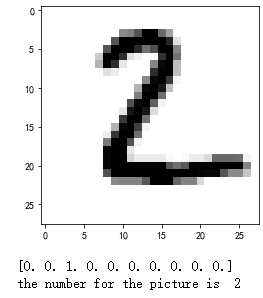from keras.datasets import mnist
(train_images, train_labels),(test_images, test_labels) = mnist.load_data()
print(train_images.shape)




digit = test_images[0]
import matplotlib.pyplot as plt
plt.figure()
plt.imshow(digit, cmap=plt.cm.binary)
plt.show()

from keras import models
from keras import layers
network = models.Sequential()
network.add(layers.Dense(512, activation='relu', input_shape=(28*28,)))
network.add(layers.Dense(10, activation="softmax"))
network.compile(optimizer='rmsprop', loss='categorical_crossentropy', metrics=['accuracy'])
train_images = train_images.reshape((60000, 28*28))
train_images = train_images.astype('float32') / 255
test_images = test_images.reshape(10000, 28*28)
test_images = test_images.astype('float32') / 255
'''
图片对应的标签是一个数值,用于表示图片内容。例如手写数字图片7,它对应的标签就是数字7,
但网络擅长于处理向量类型的数据,因为我们要将图片区分成10个分类,因此我们将标签转换为
含有10个元素的向量,对于数字7,我们将向量的第7个分量设置为1,其余设置为0
'''
from keras.utils import to_categorical
print("before change:", test_labels[0])
train_labels = to_categorical(train_labels)
test_labels = to_categorical(test_labels)
print("after change:", test_labels[0])

'''
epochs = 5表示使用输入的数据循环训练网络5次,batch_size表示网络每次从
输入数据集中抽取出128份数据进行计算
'''
network.fit(train_images, train_labels, epochs=5, batch_size=128)

'''
让训练后的网络对测试数据进行预测,检验网络的预测准确率
'''
test_loss, test_acc = network.evaluate(test_images, test_labels, verbose=1)
print('test_acc:', test_acc)

from keras.datasets import mnist
'''
上面代码只是检测网络的预测准确率,为了更形象的展示网络识别能力,我们专门从测试数据集中
抽取一张图片,让网络判断图片里面的数字
'''
(train_images, train_labels),(test_images, test_labels) = mnist.load_data()
digit = test_images[1]
plt.imshow(digit, cmap=plt.cm.binary)
plt.show()
#将抽取的图片输入网络,并让网络判断图片表示的数值
test_images = test_images.reshape(10000, 28*28)
res = network.predict(test_images)
print(res[1])
for i in range(res[1].shape[0]):
if (res[1][i] == 1):
print("the number for the picture is ", i)
break









